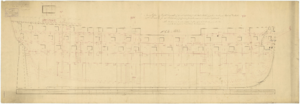HMS Chatham (1812) facts for kids

Chatham
|
|
Quick facts for kids History |
|
|---|---|
| Name | HMS Chatham |
| Ordered | 1810 |
| Builder | Woolwich Dockyard |
| Laid down | June 1810 |
| Launched | 14 February 1812 |
| Completed | By 25 April 1812 |
| Fate | Sold on 10 September 1817 |
| General characteristics | |
| Class and type | 74-gun third-rate ship of the line |
| Tons burthen | 1,860 25⁄94 bm |
| Length |
|
| Beam | 48 ft 10 in (14.9 m) |
| Depth of hold | 21 ft 6.5 in (6.6 m) |
| Propulsion | Sails |
| Sail plan | Full-rigged ship |
| Complement | 590 |
| Armament |
|
HMS Chatham was a powerful warship of the Royal Navy in the early 1800s. She was a "74-gun ship of the line," meaning she carried 74 cannons and was one of the main types of warships at the time. Interestingly, she was not originally built for the British! She was planned by the French Navy and was supposed to be called Royal-Hollandais.
The British captured her while she was still being built during a military operation called the Walcheren Campaign in 1809. After being brought to London, she was finished for the Royal Navy and launched in 1812. Chatham had a short career, mostly sailing in the North Sea. She even served as a flagship, which means she carried a high-ranking officer. Sadly, the wood used to build her wasn't very good, which limited how long she could serve. She was eventually turned into a hulk (a ship used for storage or as a base) and sold in 1817, just five years after she was launched.
Contents
Building and Capture of the Ship
This ship was first started for the French Navy in a place called Flushing in the Kingdom of Holland. She was designed to be a smaller version of the Téméraire-class class of warships. Her French name would have been Royal-Hollandais.
How the British Got Her
In 1809, the British military launched the Walcheren Campaign. During this campaign, the town of Flushing was captured by the British on August 17, 1809. The Royal-Hollandais was still being built on the slipway (the ramp where ships are constructed). The British found her parts, carefully took them apart, and shipped them back to London.
Rebuilding in England
Once in London, the ship's parts were put back together at Woolwich Dockyard. This process started in June 1810. The British also found other ships being built there. Some were destroyed, but a newly built frigate named Fidèle was sailed to England and finished there as HMS Laurel. HMS Chatham was officially launched from Woolwich on February 14, 1812. She was fully completed and ready for service by April 25, 1812.
Ship's Size and Weapons
When finished, Chatham was a large ship. She measured about 54 meters (177 feet 9 inches) long on her main gun deck. Her widest point, called the beam, was about 14.8 meters (48 feet 10 inches). She needed a crew of 590 sailors to operate.
Chatham carried many powerful guns:
- Her lower deck had 28 large 32-pounder cannons.
- The upper deck had 28 slightly smaller 24-pounder cannons.
- On her quarterdeck, she had four 12-pounder cannons and ten 32-pounder carronades (a type of short, powerful cannon).
- Her forecastle (the front part of the upper deck) had two 12-pounder cannons and two 32-pounder carronades.
- She also had six 18-pounder carronades on her roundhouse (a small structure at the stern).
Service Life of HMS Chatham
Unfortunately, the wood used to build Chatham was not of the best quality. This meant her time in service was quite short.
Early Commands
She was first put into service in March 1812. Her first captain was Captain Graham Moore. Later that year, in September, Captain Robert Maunsell took command after Captain Moore was promoted. At this time, Chatham was serving as the flagship for Rear-Admiral Matthew Scott in the North Sea.
End of Service
By July 1814, Chatham was no longer a fully active warship. She was turned into a sheer hulk, which is a ship used for other purposes, like a floating crane or storage. David Lloyd took command of her in this role. After the Napoleonic Wars ended, she was finally laid up (taken out of service) at Chatham Dockyard in November 1815. She was sold on September 10, 1817, for £5,110, and then taken apart.

